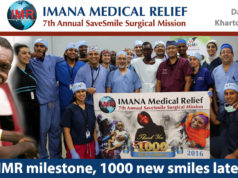IMANA Medical Relief
Cataract Mission
Amman, Jordan, December 11 – 14, 2016
Mission Report
Prepared by: Dr. Baseer Khan, MD, FRCS(C), P.CEO.
Assistant Professor, University of Toronto
This report is to serve as an overview and summary of the Cataract Surgery Mission organized by IMANA in collaboration with UMR and the UNHRC. The visiting team comprised of Drs. Baseer Khan, Michelle Khan and Ms. Heather Coulter.
Cataract surgery is the most common cause of vision loss globally and is completely reversible with surgery. There simply is no other surgery can have such a profound effect on a patients’ life with minimal post-operative care and resources, especially in just a small duration of time.
The patients had been prescreened, assessed and pre-operatively
managed by the doctors at Shami Eye Centre which included clinical evolution of their cataracts and other co-morbid conditions and extensive pre-operative diagnostics. Pre-operative visions ranged from 20/50 to light perception and had a host of co-morbidities, including but not limited diabetic retinopathy,
corneal lesions and congenital malformations. In total 66 patients, requiring 88 surgeries were identified prior to the mission.
With the use of one operating room for the majority of the time, a total of 109 surgeries were performed. The range of complexity of these cataracts was diverse from routine cataracts to fairly complex, with equal representation over the spectrum. Of the original 66 patients, one patient who was scheduled for bilateral surgery was unable to undergo the second eye due to systemic comorbidities. Another patient passed away the day prior to surgery. Recognizing the capacity of the visiting team, the Shami doctors added a number of patients to the list of patients and surgeries to be performed. In addition to cataract surgery, a number of tertiary level surgical procedures were also performed at the request of the Shami doctors; 1 pterygium, 2 secondary intra-ocular lens implantation with iris fixation for aphakia, and 1
Ahmed Glaucoma Valve surgeries were also performed.
There was a 1 case of a posterior capsular rupture with no nucleus lost, and the lens was still implanted in the capsular bag, thereby not requiring any further intervention. There were no other complications that arose intraoperatively. Post-operative outcomes were good, other than some patients with advanced cataracts pre-operatively manifested some corneal edema,
which was expected to resolve without issue.
In summary, the mission was a remarkable success given that the visiting team and the local team from Shami had never worked together. The nursing and administrative team at Shami were very proficient and flexible in adapting to the surgical team and moving through large numbers of patients compared to their usual volumes. This mission certainly serves as high bench mark for future missions to be measured but demonstrates the efficacy of IMANA to deliver high quality and efficient care in this domain.










